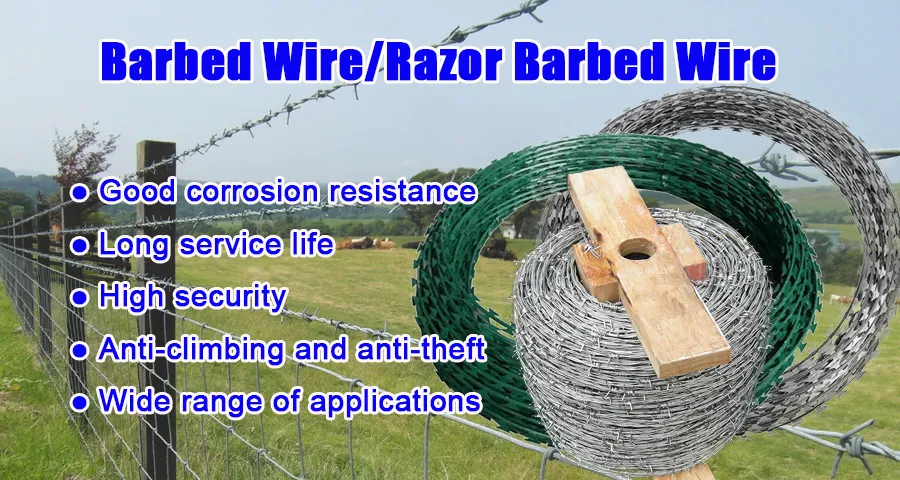-
+86 15030157877
-
sales@galvanizedmetalmesh.com
Oct . 01, 2024 08:26 Back to list
The Intricacies and Uses of Barbed Wire in Modern Security Solutions
The Symbolism of Barbed Wire More than Just a Security Measure
Barbed wire, a ubiquitous yet often overlooked aspect of modern fencing, serves as both a practical barrier and a powerful symbol in various contexts. Initially designed for enclosing livestock, its applications have expanded dramatically since its invention in the late 19th century. Today, barbed wire is prominently featured in military installations, prisons, and borders across the globe, embodying themes of security, division, and control. However, its significance transcends mere physical containment, intertwining with social, political, and psychological dimensions.
The origins of barbed wire can be traced back to the 1860s, when farmers sought a means to protect their fields from livestock wandering off. With its sharp points and twisted strands, the invention of barbed wire revolutionized agriculture, allowing for the efficient segmentation of land. It provided a sense of security for farmers who were desperate to keep their crops safe and their livestock corralled. Barbed wire became synonymous with the American frontier; it marked property lines, maintained order, and established claims in an era defined by expansion and territorial disputes. The iconic imagery of barbed wire became deeply ingrained in American culture, representing resilience and the taming of the wild.
As the 20th century unfurled, the role of barbed wire expanded from agricultural use to applications in military and detention contexts. During World War I, barbed wire became a prominent feature of the trenches, creating a physical and psychological barrier that embodied the horrors of war. Soldiers faced the terrifying reality of the trenches lined with barbed wire, which not only served to inhibit enemy advances but also symbolized the death and destruction that characterized the Great War. In this sense, barbed wire evolved into a metaphor for human conflict, sacrifice, and the complexities of national security.
barbed wire

In contemporary society, the use of barbed wire has become a marker of division, particularly in the context of borders and immigration. Countries around the world have installed barbed wire fences to deter illegal crossings and to regulate the flow of migrants. This practice raises ethical questions about human rights and the treatment of individuals seeking asylum or a better life. The stark imagery of barbed wire along borders often reflects the fear and societal attitudes towards the “other,” emphasizing the divide between nations and cultures. It serves as a physical manifestation of political ideologies surrounding sovereignty, safety, and exclusion.
Furthermore, barbed wire is commonly associated with prisons and correctional facilities, representing confinement and punishment. Its presence evokes a sense of desolation and fear, marking facilities that house individuals separated from society due to their actions. The harshness of barbed wire encircling a prison can symbolize both a society’s desire for order and the potential for inhumanity within its systems. In this environment, it becomes a reminder of the delicate balance between security and freedom, and the moral implications of incarceration.
On a psychological level, barbed wire also invokes feelings of entrapment and isolation. For many, the sight of barbed wire can trigger sentiments of fear and despair, reminding them of the restrictions placed upon them—whether self-imposed or externally enforced. It acts as a visual representation of barriers that exist in our own lives, metaphorically illustrating the barriers we construct against vulnerability, connection, and understanding.
In conclusion, barbed wire is much more than a mere material object; it is a complex symbol interwoven with various narratives that highlight themes of security, division, and control. Its origins in agricultural practices speak to our human desire for safety and order, while its contemporary applications expose the darker facets of societal attitudes toward borders, imprisonment, and power dynamics. As we navigate our increasingly complex world, understanding the role of symbols like barbed wire invites deeper reflection on how we build barriers—both physical and psychological—and the consequences these barriers may entail for personal and collective human experiences. Ultimately, barbed wire reminds us of the thin line between security and confinement, and the multifaceted implications of the barriers we create.
-
3D Curved Welded Wire Mesh Fence for Secure & Stylish Fencing Solutions
NewsJul.28,2025
-
Spiral Plant Stick for Tomato Support - Durable & Easy to Install
NewsJul.27,2025
-
Stainless Steel Wire Mesh Roll Wholesale & Manufacturers – Quality Exporters
NewsJul.26,2025
-
High Quality 3D Curved Welded Wire Mesh Fence for Security and Aesthetics
NewsJul.25,2025
-
High-Quality Security Window Screen Mesh for Home & Office Protection
NewsJul.24,2025
-
Hexagonal Gabion for River Bank Protection and Retaining Walls
NewsJul.23,2025



